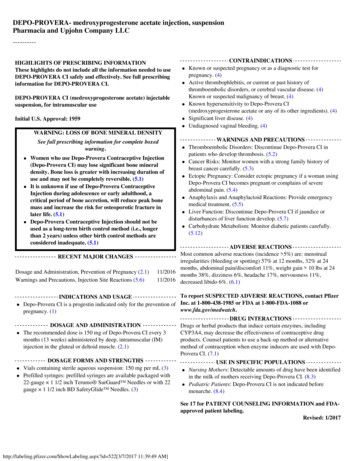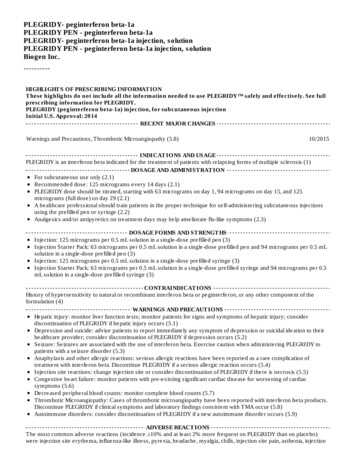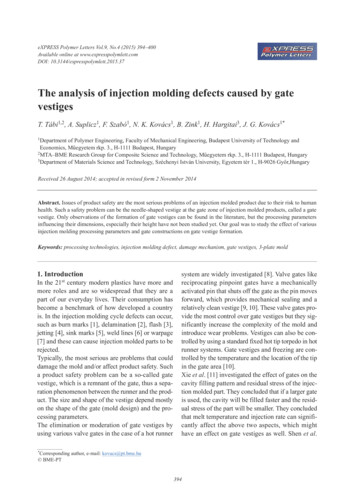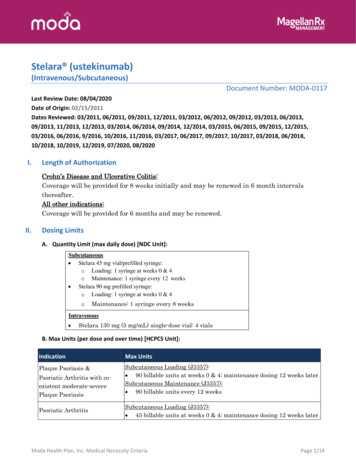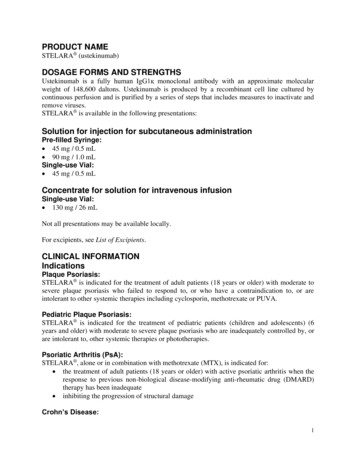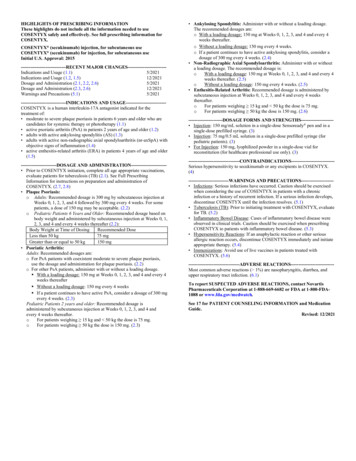
Transcription
HIGHLIGHTS OF PRESCRIBING INFORMATIONThese highlights do not include all the information needed to useCOSENTYX safely and effectively. See full prescribing information forCOSENTYX.COSENTYX (secukinumab) injection, for subcutaneous useCOSENTYX (secukinumab) for injection, for subcutaneous useInitial U.S. Approval: 2015-----------------------------RECENT MAJOR CHANGES------------------------Indications and Usage (1.1)5/2021Indications and Usage (1.2, 1.5)12/2021Dosage and Administration (2.1, 2.2, 2.6)5/2021Dosage and Administration (2.3, 2.6)12/2021Warnings and Precautions S AND USAGE-------------------------COSENTYX is a human interleukin-17A antagonist indicated for thetreatment of: moderate to severe plaque psoriasis in patients 6 years and older who arecandidates for systemic therapy or phototherapy (1.1) active psoriatic arthritis (PsA) in patients 2 years of age and older (1.2) adults with active ankylosing spondylitis (AS) (1.3) adults with active non-radiographic axial spondyloarthritis (nr-axSpA) withobjective signs of inflammation (1.4) active enthesitis-related arthritis (ERA) in patients 4 years of age and older(1.5)-----------------------DOSAGE AND ADMINISTRATION---------------------- Prior to COSENTYX initiation, complete all age appropriate vaccinations,evaluate patients for tuberculosis (TB) (2.1). See Full PrescribingInformation for instructions on preparation and administration ofCOSENTYX. (2.7, 2.8) Plaque Psoriasis:o Adults: Recommended dosage is 300 mg by subcutaneous injection atWeeks 0, 1, 2, 3, and 4 followed by 300 mg every 4 weeks. For somepatients, a dose of 150 mg may be acceptable. (2.2)o Pediatric Patients 6 Years and Older: Recommended dosage based onbody weight and administered by subcutaneous injection at Weeks 0, 1,2, 3, and 4 and every 4 weeks thereafter (2.2):Body Weight at Time of DosingRecommended DoseLess than 50 kg75 mgGreater than or equal to 50 kg150 mg Psoriatic Arthritis:Adults: Recommended dosages are:o For PsA patients with coexistent moderate to severe plaque psoriasis,use the dosage and administration for plaque psoriasis. (2.2)o For other PsA patients, administer with or without a loading dosage. With a loading dosage: 150 mg at Weeks 0, 1, 2, 3, and 4 and every 4weeks thereafter Without a loading dosage: 150 mg every 4 weeks If a patient continues to have active PsA, consider a dosage of 300 mgevery 4 weeks. (2.3)Pediatric Patients 2 years and older: Recommended dosage isadministered by subcutaneous injection at Weeks 0, 1, 2, 3, and 4 andevery 4 weeks thereafter.oFor patients weighing 15 kg and 50 kg the dose is 75 mg.oFor patients weighing 50 kg the dose is 150 mg. (2.3) Ankylosing Spondylitis: Administer with or without a loading dosage.The recommended dosages are:o With a loading dosage: 150 mg at Weeks 0, 1, 2, 3, and 4 and every 4weeks thereafter.o Without a loading dosage: 150 mg every 4 weeks.o If a patient continues to have active ankylosing spondylitis, consider adosage of 300 mg every 4 weeks. (2.4) Non-Radiographic Axial Spondyloarthritis: Administer with or withouta loading dosage. The recommended dosage is:oWith a loading dosage: 150 mg at Weeks 0, 1, 2, 3, and 4 and every 4weeks thereafter. (2.5)oWithout a loading dosage: 150 mg every 4 weeks. (2.5) Enthesitis-Related Arthritis: Recommended dosage is administered bysubcutaneous injection at Weeks 0, 1, 2, 3, and 4 and every 4 weeksthereafter.oFor patients weighing 15 kg and 50 kg the dose is 75 mg.oFor patients weighing 50 kg the dose is 150 mg. (2.6)----------------------DOSAGE FORMS AND STRENGTHS-------------------- Injection: 150 mg/mL solution in a single-dose Sensoready pen and in asingle-dose prefilled syringe. (3) Injection: 75 mg/0.5 mL solution in a single-dose prefilled syringe (forpediatric patients). (3) For Injection: 150 mg, lyophilized powder in a single-dose vial forreconstitution (for healthcare professional use only). ONS---------------------------Serious hypersensitivity to secukinumab or any excipients in COSENTYX.(4)--------------------------WARNINGS AND PRECAUTIONS-------------------- Infections: Serious infections have occurred. Caution should be exercisedwhen considering the use of COSENTYX in patients with a chronicinfection or a history of recurrent infection. If a serious infection develops,discontinue COSENTYX until the infection resolves. (5.1) Tuberculosis (TB): Prior to initiating treatment with COSENTYX, evaluatefor TB. (5.2) Inflammatory Bowel Disease: Cases of inflammatory bowel disease wereobserved in clinical trials. Caution should be exercised when prescribingCOSENTYX to patients with inflammatory bowel disease. (5.3) Hypersensitivity Reactions: If an anaphylactic reaction or other seriousallergic reaction occurs, discontinue COSENTYX immediately and initiateappropriate therapy. (5.4) Immunizations: Avoid use of live vaccines in patients treated withCOSENTYX. (5.6)---------------------------------ADVERSE REACTIONS---------------------------Most common adverse reactions ( 1%) are nasopharyngitis, diarrhea, andupper respiratory tract infection. (6.1)To report SUSPECTED ADVERSE REACTIONS, contact NovartisPharmaceuticals Corporation at 1-888-669-6682 or FDA at 1-800-FDA1088 or www.fda.gov/medwatch.See 17 for PATIENT COUNSELING INFORMATION and MedicationGuide.Revised: 12/2021
FULL PRESCRIBING INFORMATION: CONTENTS*1INDICATIONS AND USAGE1.11.21.31.41.52DOSAGE AND g and Procedures Prior to Treatment InitiationPlaque PsoriasisPsoriatic ArthritisAnkylosing SpondylitisNon-Radiographic Axial SpondyloarthritisEnthesitis-Related ArthritisImportant Administration InstructionsPreparation for Use of COSENTYX Sensoready Pen and Prefilled SyringeReconstitution and Preparation of COSENTYX Lyophilized Powder78InfectionsPre-Treatment Evaluation for TuberculosisInflammatory Bowel DiseaseHypersensitivity ReactionsRisk of Hypersensitivity in Latex-Sensitive IndividualsImmunizationsADVERSE REACTIONS6.16.2Clinical Trials ExperienceImmunogenicityDRUG INTERACTIONSUSE IN SPECIFIC POPULATIONS8.18.28.48.510111213Carcinogenesis, Mutagenesis, Impairment of FertilityCLINICAL STUDIES14.114.214.314.414.514.616Mechanism of ActionPharmacodynamicsPharmacokineticsNONCLINICAL TOXICOLOGY13.114PregnancyLactationPediatric UseGeriatric UseOVERDOSAGEDESCRIPTIONCLINICAL PHARMACOLOGY12.112.212.3DOSAGE FORMS AND STRENGTHSCONTRAINDICATIONSWARNINGS AND PRECAUTIONS5.15.25.35.45.55.66Plaque PsoriasisPsoriatic ArthritisAnkylosing SpondylitisNon-Radiographic Axial SpondyloarthritisEnthesitis-Related ArthritisAdult Plaque PsoriasisPediatric Plaque PsoriasisAdult Psoriatic ArthritisAnkylosing SpondylitisNon-Radiographic Axial SpondyloarthritisJuvenile Psoriatic Arthritis and Enthesitis-Related ArthritisHOW SUPPLIED/STORAGE AND HANDLING16.116.2How SuppliedStorage and Handling17 PATIENT COUNSELING INFORMATION*Sections or subsections omitted from the full prescribing information are notlisted.
FULL PRESCRIBING INFORMATION1INDICATIONS AND USAGE1.1Plaque PsoriasisCOSENTYX is indicated for the treatment of moderate to severe plaque psoriasis in patients 6 years and older who arecandidates for systemic therapy or phototherapy.1.2Psoriatic ArthritisCOSENTYX is indicated for the treatment of active psoriatic arthritis (PsA) in patients 2 years of age and older.1.3Ankylosing SpondylitisCOSENTYX is indicated for the treatment of adult patients with active ankylosing spondylitis (AS).1.4Non-Radiographic Axial SpondyloarthritisCOSENTYX is indicated for the treatment of adult patients with active non-radiographic axial spondyloarthritis (nraxSpA) with objective signs of inflammation.1.5Enthesitis-Related ArthritisCOSENTYX is indicated for the treatment of active enthesitis-related arthritis (ERA) in patients 4 years of age and older.2DOSAGE AND ADMINISTRATION2.1Testing and Procedures Prior to Treatment Initiation Perform the following evaluations prior to COSENTYX initiation:o Evaluate patients for tuberculosis (TB) infection. COSENTYX initiation is not recommended in patients with activeTB infection. Initiate treatment of latent TB prior to initiation of COSENTYX [see Warnings and Precautions(5.2)].o Complete all age-appropriate vaccinations as recommended by current immunization guidelines prior to initiatingtreatment with COSENTYX [see Warnings and Precautions (5.6)].2.2Plaque PsoriasisAdultsThe recommended dosage is 300 mg by subcutaneous injection at Weeks 0, 1, 2, 3, and 4 followed by 300 mg every 4weeks. Each 300 mg dosage is given as 2 subcutaneous injections of 150 mg.For some patients, a dose of 150 mg may be acceptable.Pediatric PatientsThe recommended dosage for pediatric patients 6 years of age and older is based on body weight (Table 1) andadministered by subcutaneous injection at Weeks 0, 1, 2, 3, and 4 followed by dosing every 4 weeks.Table 1: Recommended Dose of COSENTYX for Pediatric Patients 6 Years of Age and Older with PlaquePsoriasisBody Weight at Time of DosingRecommended DoseLess than 50 kg75 mgGreater than or equal to 50 kg150 mg2.3Psoriatic ArthritisAdultsFor PsA patients with coexistent moderate to severe plaque psoriasis, use the dosing and administration recommendationsfor plaque psoriasis [see Dosage and Administration (2.1)].
For other PsA patients, administer COSENTYX with or without a loading dosage by subcutaneous injection. Therecommended dosage: With a loading dosage is 150 mg at Weeks 0, 1, 2, 3, and 4 and every 4 weeks thereafter Without a loading dosage is 150 mg every 4 weeks If a patient continues to have active PsA, consider a dosage of 300 mg every 4 weeks.Pediatric PatientsThe recommended dose based on body weight is administered by subcutaneous injection at Weeks 0, 1, 2, 3, and 4 andevery 4 weeks thereafter. For patients weighing 15 kg and 50 kg the recommended dose is 75 mg For patients weighing 50 kg the recommended dose is 150 mgCOSENTYX may be administered with or without methotrexate.2.4Ankylosing SpondylitisAdminister COSENTYX with or without a loading dosage by subcutaneous injection. The recommended dosage: With a loading dosage is 150 mg at Weeks 0, 1, 2, 3, and 4 and every 4 weeks thereafter Without a loading dosage is 150 mg every 4 weeks If a patient continues to have active AS, consider a dosage of 300 mg every 4 weeks.2.5Non-Radiographic Axial SpondyloarthritisAdminister COSENTYX with or without a loading dosage by subcutaneous injection. The recommended dosage:2.6 With a loading dosage is 150 mg at Weeks 0, 1, 2, 3, and 4 and every 4 weeks thereafter Without a loading dosage is 150 mg every 4 weeksEnthesitis-Related ArthritisThe recommended dose based on body weight is administered by subcutaneous injection at Weeks 0, 1, 2, 3, and 4 andevery 4 weeks thereafter. For patients weighing 15 kg and 50 kg the recommended dose is 75 mg For patients weighing 50 kg the recommended dose is 150 mg2.7Important Administration InstructionsThere are four presentations for COSENTYX (i.e., Sensoready pen, prefilled syringes [150 mg/mL, 75 mg/0.5 mL], andlyophilized powder in vial for reconstitution). The COSENTYX “Instructions for Use” for each presentation containsmore detailed instructions on the preparation and administration of COSENTYX [see Instructions for Use]. Thelyophilized powder in vial for reconstitution is for healthcare provider use only.COSENTYX is intended for use under the guidance and supervision of a physician.Sensoready PenAdult patients may self-administer COSENTYX or be injected by a caregiver after proper training in subcutaneousinjection technique using the Sensoready pen.Pediatric patients should not self-administer COSENTYX using the Sensoready pen. An adult caregiver should prepareand inject COSENTYX after proper training in subcutaneous injection technique using the Sensoready pen.Prefilled SyringeAdult patients may self-administer COSENTYX or be injected by a caregiver after proper training in subcutaneousinjection technique using the prefilled syringe.Pediatric patients should not self-administer COSENTYX using the prefilled syringe. An adult caregiver should prepareand inject COSENTYX after proper training in subcutaneous injection technique using the prefilled syringe.
Administration InstructionsAdminister each injection at a different anatomic location (such as upper arms, thighs, or any quadrant of abdomen) thanthe previous injection, and not into areas where the skin is tender, bruised, erythematous, indurated, or affected bypsoriasis. Administration of COSENTYX in the upper, outer arm may be performed by a caregiver or healthcare provider.2.8Preparation for Use of COSENTYX Sensoready Pen and Prefilled SyringeBefore injection, remove COSENTYX Sensoready pen or COSENTYX prefilled syringe from the refrigerator and allowCOSENTYX to reach room temperature (15 to 30 minutes) without removing the needle cap.The removable cap of the COSENTYX Sensoready pen and the COSENTYX prefilled syringe contain natural rubberlatex and should not be handled by latex-sensitive individuals [see Warnings and Precautions (5.5)].Inspect COSENTYX visually for particulate matter and discoloration prior to administration. COSENTYX injection is aclear to slightly opalescent, colorless to slightly yellow solution. Do not use if the liquid contains visible particles, isdiscolored or cloudy. COSENTYX does not contain preservatives; therefore, administer the Sensoready pen or prefilledsyringe within 1 hour after removal from the refrigerator. Discard any unused product remaining in the Sensoready pen orprefilled syringe.2.9Reconstitution and Preparation of COSENTYX Lyophilized PowderCOSENTYX lyophilized powder should be prepared and reconstituted with Sterile Water for Injection by a trainedhealthcare provider using aseptic technique and without interruption. The preparation time from piercing the stopper untilend of reconstitution on average takes 20 minutes and should not exceed 90 minutes.a) Remove the vial of COSENTYX lyophilized powder from the refrigerator and allow to stand for 15 to 30 minutes toreach room temperature. Ensure the Sterile Water for Injection is at room temperature.b) Slowly inject 1 mL of Sterile Water for Injection into the vial containing COSENTYX lyophilized powder and directthe stream of Sterile Water for Injection onto the lyophilized powder.c) Tilt the vial at an angle of approximately 45 degrees and gently rotate between the fingertips for approximately 1minute. Do not shake or invert the vial.d) Allow the vial to stand for about 10 minutes at room temperature to allow for dissolution. Note that foaming mayoccur.e) Tilt the vial at an angle of approximately 45 degrees and gently rotate between the fingertips for approximately 1minute. Do not shake or invert the vial.f) Allow the vial to stand undisturbed at room temperature for approximately 5 minutes. The reconstituted COSENTYXsolution should be essentially free of visible particles, clear to opalescent, and colorless to slightly yellow. Do not use ifthe lyophilized powder has not fully dissolved or if the liquid contains visible particles, is cloudy or discolored.g) Prepare the required number of vials (1 vial for the 150 mg dose or 2 vials for the 300 mg dose).h) The COSENTYX reconstituted solution contains 150 mg of secukinumab in 1 mL of solution. After reconstitution, usethe solution immediately or store in the refrigerator at 2ºC to 8ºC (36ºF to 46ºF) for up to 24 hours. Do not freeze.i) If stored at 2ºC to 8ºC (36ºF to 46ºF), allow the reconstituted COSENTYX solution to reach room temperature (15 to 30minutes) before administration. COSENTYX does not contain preservatives; therefore, administer within 1 hour afterremoval from 2ºC to 8ºC (36ºF to 46ºF) storage.3 DOSAGE FORMS AND STRENGTHSInjection: 150 mg/mL as a clear to opalescent, colorless to slightly yellowish solution in a single-dose Sensoready penInjection: 150 mg/mL as a clear to opalescent, colorless to slightly yellowish solution in a single-dose prefilledsyringeInjection: 75 mg/0.5 mL as a clear to opalescent, colorless to slightly yellowish solution in a single-dose prefilledsyringe (for pediatric patients less than 50 kg)For injection: 150 mg white lyophilized powder in a single-dose vial for reconstitution (for healthcare professional useonly)
4CONTRAINDICATIONSCOSENTYX is contraindicated in patients with a previous serious hypersensitivity reaction to secukinumab or to any ofthe excipients in COSENTYX. Cases of anaphylaxis have been reported during treatment with COSENTYX [seeWarnings and Precautions (5.4)].5WARNINGS AND PRECAUTIONS5.1InfectionsCOSENTYX may increase the risk of infections. In clinical trials, a higher rate of infections was observed inCOSENTYX treated subjects compared to placebo-treated subjects. In placebo-controlled clinical trials in subjects withmoderate to severe plaque psoriasis, higher rates of common infections, such as nasopharyngitis (11.4% versus 8.6%),upper respiratory tract infection (2.5% versus 0.7%) and mucocutaneous infections with candida (1.2% versus 0.3%) wereobserved with COSENTYX compared with placebo. A similar increase in risk of infection was seen in placebo-controlledtrials in subjects with PsA, AS and nr-axSpA. The incidence of some types of infections appeared to be dose-dependent inclinical studies [see Adverse Reactions (6.1)]. In the postmarketing setting, serious and some fatal infections have beenreported in patients receiving COSENTYX.Exercise caution when considering the use of COSENTYX in patients with a chronic infection or a history of recurrentinfection.Instruct patients to seek medical advice if signs or symptoms suggestive of an infection occur. If a patient develops aserious infection, monitor the patient closely and discontinue COSENTYX until the infection resolves.5.2Pre-Treatment Evaluation for TuberculosisEvaluate patients for tuberculosis (TB) infection prior to initiating treatment with COSENTYX. Avoid administration ofCOSENTYX to patients with active TB infection. Initiate treatment of latent TB prior to administering COSENTYX.Consider anti-TB therapy prior to initiation of COSENTYX in patients with a past history of latent or active TB in whoman adequate course of treatment cannot be confirmed. Monitor patients closely for signs and symptoms of active TBduring and after treatment.5.3Inflammatory Bowel DiseaseCaution should be used when prescribing COSENTYX to patients with inflammatory bowel disease. Exacerbations, insome cases serious, occurred in COSENTYX treated subjects during clinical trials in plaque psoriasis, PsA, AS and nraxSpA. In addition, new onset inflammatory bowel disease cases occurred in clinical trials with COSENTYX. In anexploratory trial in 59 subjects with active Crohn’s disease, there were trends toward greater disease activity and increasedadverse events in the secukinumab group as compared to the placebo group. Patients who are treated with COSENTYXshould be monitored for signs and symptoms of inflammatory bowel disease [see Adverse Reactions (6.1)].5.4Hypersensitivity ReactionsAnaphylaxis and cases of urticaria occurred in COSENTYX treated subjects in clinical trials. If an anaphylactic or otherserious allergic reaction occurs, administration of COSENTYX should be discontinued immediately and appropriatetherapy initiated [see Contraindications (4), Adverse Reactions (6.1)].5.5Risk of Hypersensitivity in Latex-Sensitive IndividualsThe removable caps of the COSENTYX Sensoready pen and the COSENTYX 1 mL and 0.5 mL prefilled syringescontain natural rubber latex, which may cause an allergic reaction in latex-sensitive individuals. The safe use ofCOSENTYX Sensoready pen or prefilled syringe in latex-sensitive individuals has not been studied.5.6ImmunizationsPrior to initiating therapy with COSENTYX, consider completion of all age appropriate immunizations according tocurrent immunization guidelines. COSENTYX may alter a patient’s immune response to live vaccines. Avoid use of livevaccines in patients treated with COSENTYX [see Clinical Pharmacology (12.2)].
6ADVERSE REACTIONSThe following adverse reactions are discussed in greater detail elsewhere in the labeling: Infections [see Warnings and Precautions (5.1)] Inflammatory Bowel Disease [see Warnings and Precautions (5.3)] Hypersensitivity Reactions [see Warnings and Precautions (5.4)]6.1Clinical Trials ExperienceBecause clinical trials are conducted under widely varying conditions, adverse reaction rates observed in the clinical trialsof a drug cannot be directly compared to rates in the clinical trials of another drug and may not reflect the rates observedin practice.Adult Plaque PsoriasisA total of 3430 plaque psoriasis subjects were treated with COSENTYX in controlled and uncontrolled clinical trials. Ofthese, 1641 subjects were exposed for at least 1 year.Four placebo-controlled Phase 3 trials in plaque psoriasis subjects were pooled to evaluate the safety of COSENTYX incomparison to placebo up to 12 weeks after treatment initiation, in Trials PsO1, PsO2, PsO3, and PsO4. In total, 2077subjects were evaluated (691 to COSENTYX 300 mg group, 692 to COSENTYX 150 mg group, and 694 to placebogroup). Subjects randomized to COSENTYX received 300 mg or 150 mg doses subcutaneously at Weeks 0, 1, 2, 3, and 4followed by the same dose every 4 weeks [see Clinical Studies (14)].Table 2 summarizes the adverse reactions that occurred at a rate of at least 1% and at a higher rate in the COSENTYXgroups than the placebo group during the 12-week placebo-controlled period of the placebo-controlled trials.Table 2: Adverse Reactions Reported by Greater Than 1% of Subjects With Plaque Psoriasis Through Week 12 inTrials PsO1, PsO2, PsO3, and PsO4COSENTYXAdverse Reactions300 mg150 mgPlacebo(N 691)(N 692)(N 694)n (%)n (%)n (%)Nasopharyngitis79 (11.4)85 (12.3)60 (8.6)Diarrhea28 (4.1)18 (2.6)10 (1.4)Upper respiratory tract infection17 (2.5)22 (3.2)5 (0.7)Rhinitis10 (1.4)10 (1.4)5 (0.7)Oral herpes9 (1.3)1 (0.1)2 (0.3)Pharyngitis8 (1.2)7 (1.0)0 (0)Urticaria4 (0.6)8 (1.2)1 (0.1)Rhinorrhea8 (1.2)2 (0.3)1 (0.1)Adverse reactions that occurred at rates less than 1% in the placebo-controlled period of Trials PsO1, PsO2, PsO3, andPsO4 through Week 12 included: sinusitis, tinea pedis, conjunctivitis, tonsillitis, oral candidiasis, impetigo, otitis media,otitis externa, inflammatory bowel disease, increased liver transaminases, and neutropenia.
InfectionsIn the placebo-controlled period of the clinical trials in plaque psoriasis (a total of 1382 subjects treated with COSENTYXand 694 subjects treated with placebo up to 12 weeks), infections were reported in 28.7% of subjects treated withCOSENTYX compared with 18.9% of subjects treated with placebo. Serious infections occurred in 0.14% of subjectstreated with COSENTYX and in 0.3% of subjects treated with placebo.Over the entire treatment period (a total of 3430 plaque psoriasis subjects treated with COSENTYX for up to 52 weeks forthe majority of subjects), infections were reported in 47.5% of subjects treated with COSENTYX (0.9 per patient-year offollow-up). Serious infections were reported in 1.2% of subjects treated with COSENTYX (0.015 per patient-year offollow-up).Phase 3 data showed an increasing trend for some types of infection with increasing serum concentration of secukinumab.Candida infections, herpes viral infections, staphylococcal skin infections, and infections requiring treatment increased asserum concentration of secukinumab increased.In the psoriasis open-label extension of Trials PsO1 and PsO2 (median follow-up of 3.9 years), representing 3582 subjectyears of exposure, 74% of COSENTYX treated subjects reported infections (55 per 100 patient-years). Serious infectionswere reported in 4.5% of subjects (1.4 per 100 patient-years). Sepsis was reported in 5 subjects (0.2 per 100 patientyears).Neutropenia was observed in controlled portion of clinical trials. Most cases of secukinumab-associated neutropenia weretransient and reversible. No serious infections were associated with cases of neutropenia.In the open-label extension of Trials PsO1 and PsO2, neutropenia (ANC 1 x109/L) was reported in 1% of COSENTYXtreated subjects (0.3 per 100 patient-years). Some cases of serious infections were associated with neutropenia; howeverthe causal relationship was not established.Inflammatory Bowel DiseaseCases of inflammatory bowel disease, in some cases serious, were observed in clinical trials with COSENTYX. In theplaque psoriasis program, with 3430 subjects exposed to COSENTYX over the entire treatment period for up to 52 weeks(2725 patient-years), there were 3 cases (0.11 per 100 patient-years) of exacerbation of Crohn’s disease, 2 cases (0.08 per100 patient-years) of exacerbation of ulcerative colitis, and 2 cases (0.08 per 100 patient-years) of new onset ulcerativecolitis. There were no cases in placebo subjects (N 793; 176 patient-years) during the 12-week placebo-controlledperiod.One case of exacerbation of Crohn’s disease was reported in open-labeled portions of clinical trials in plaque psoriasis.Hypersensitivity ReactionsAnaphylaxis and cases of urticaria occurred in COSENTYX treated subjects in clinical trials [see Warnings andPrecautions (5.4)].Pediatric Plaque PsoriasisThe safety of COSENTYX was assessed in two Phase 3 trials in pediatric subjects with plaque psoriasis.The first was a randomized, double-blind, placebo and active-controlled, 236-week trial (Trial PsO6) that enrolled 162pediatric subjects 6 years of age and older, with severe plaque psoriasis (defined by PASI score 20, an IGA modified2011 score of 4, and involving 10% of the body surface area) who were candidates for systemic therapy. The 162subjects were randomized to receive placebo, a biologic active control, or COSENTYX. In the COSENTYX groups,subjects with body weight 25 kg received 75 mg, subjects with body weight 25 to 50 kg received either 75 mg or 150mg (2 times the recommended dose), and subjects with body weight 50 kg received either 150 mg or 300 mg (2 timesthe recommended dose).The second trial was a randomized, open-label, 208-week trial (Trial PsO7; NCT03668613) of 84 subjects 6 years of ageand older with moderate to severe plaque psoriasis (defined by a PASI score 12, IGA mod 2011 score of 3, and BSAinvolvement of 10% at randomization) who were randomized into two COSENTYX arms [Arm 1: 75 mg for bodyweight (BW) 50 kg or 150 mg for 50 kg and Arm 2: 75 mg for BW 25 kg, 150 mg for BW 25 kg and 50 kg, or300 mg for BW 50 kg].The safety profile reported in these trials was consistent with the safety profile reported in adult plaque psoriasis trials.
InfectionsOne case of methicillin-resistant Staphylococcus aureus (MRSA) toxic shock syndrome (TSS) was reported in aCOSENTYX treated subject during the placebo-controlled period.In the pediatric safety pool, which includes all subjects who took at least one dose of COSENTYX during the treatmentperiods [198 subjects (287 patient years)], 22 (11%) subjects reported CTCAE Grade 2 neutropenia ( 1,000 to 1,500cells/mm3) with 57% of subjects followed for one year or more and 30% of subjects followed for two years or more.During the placebo-controlled period which included a total of 80 subjects treated with secukinumab and 41 subjectstreated with placebo up to 12 weeks, CTCAE Grade 2 neutropenia was reported in 3 (4%) of the subjects treated withsecukinumab compared with no subjects treated with placebo. No serious infections were associated with cases ofneutropenia.Adult Psoriatic ArthritisCOSENTYX was studied in two placebo-controlled PsA trials with 1003 patients (703 patients on COSENTYX and 300patients on placebo). Of the 703 patients who received COSENTYX, 299 patients received a subcutaneous loading doseof COSENTYX (PsA1) and 404 patients received an intravenous loading dose of secukinumab (PsA2) followed byCOSENTYX administered by subcutaneous injection every four weeks. During the 16-week placebo-controlled period ofthe trials in patients with PsA, the overall proportion of patients with adverse events was similar in the secukinumab andplacebo-treatment groups (59% and 58%, respectively). The adverse events that occurred at a proportion of at least 2%and at a higher proportion in the COSENTYX groups than the placebo groups during the 16-week placebo-controlledperiod were nasopharyngitis, upper respiratory tract infection, headache, nausea, and hypercholesterolemia. The safetyprofile observed in patients with PsA treated with COSENTYX is consistent with the safety profile in psoriasis.Similar to the clinical trials in patients with psoriasis, there was an increased proportion of patients with infections in theCOSENTYX groups (29%) compared to placebo group (26%).There were cases of Crohn’s disease and ulcerative colitis that include patients who experienced either exacerbations orthe development of new disease. There were three cases of inflammatory bowel disease, of which two patients receivedsecukinumab and one received placebo.Ankylosing SpondylitisCOSENTYX was studied in two placebo-controlled AS trials with 590 patients (394 patients on COSENTYX and 196patients on placebo). Of the 394 patients who received COSENTYX, 145 patients received a subcutaneous load ofCOSENTYX (study AS1), and 249 received an intravenous loading dose of secukinumab (study AS2) followed byCOSENTYX administered by subcutaneous injection every four weeks. During the 16-week placebo-controlled period ofthe trials in patients with AS, the overall proportion of patients with adverse events was higher in the secukinumab groupsthan the placebo-treatment groups (66% and 59%, respectively). The adverse events that occurred at a proportion of atleast 2% and at a higher proportion in the COSENT
FULL PRESCRIBING INFORMATION 1 INDICATIONS AND USAGE 1.1 Plaque Psoriasis COSENTYX is indicated for the treatment of moderate to severe plaque psoriasis in patients 6 years and older who are candidates for systemic therapy or phototherapy. 1.2 Psoriatic Arthritis

